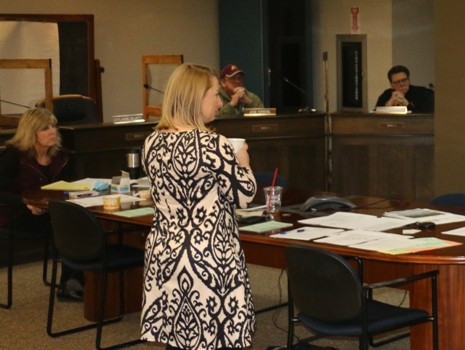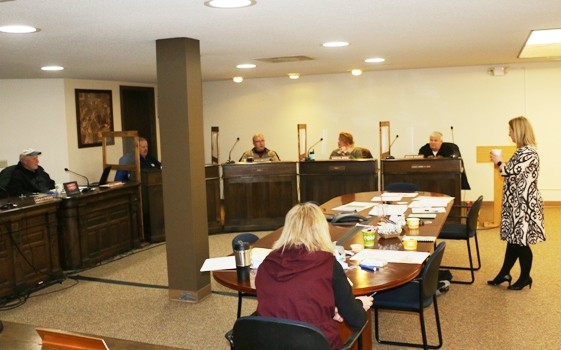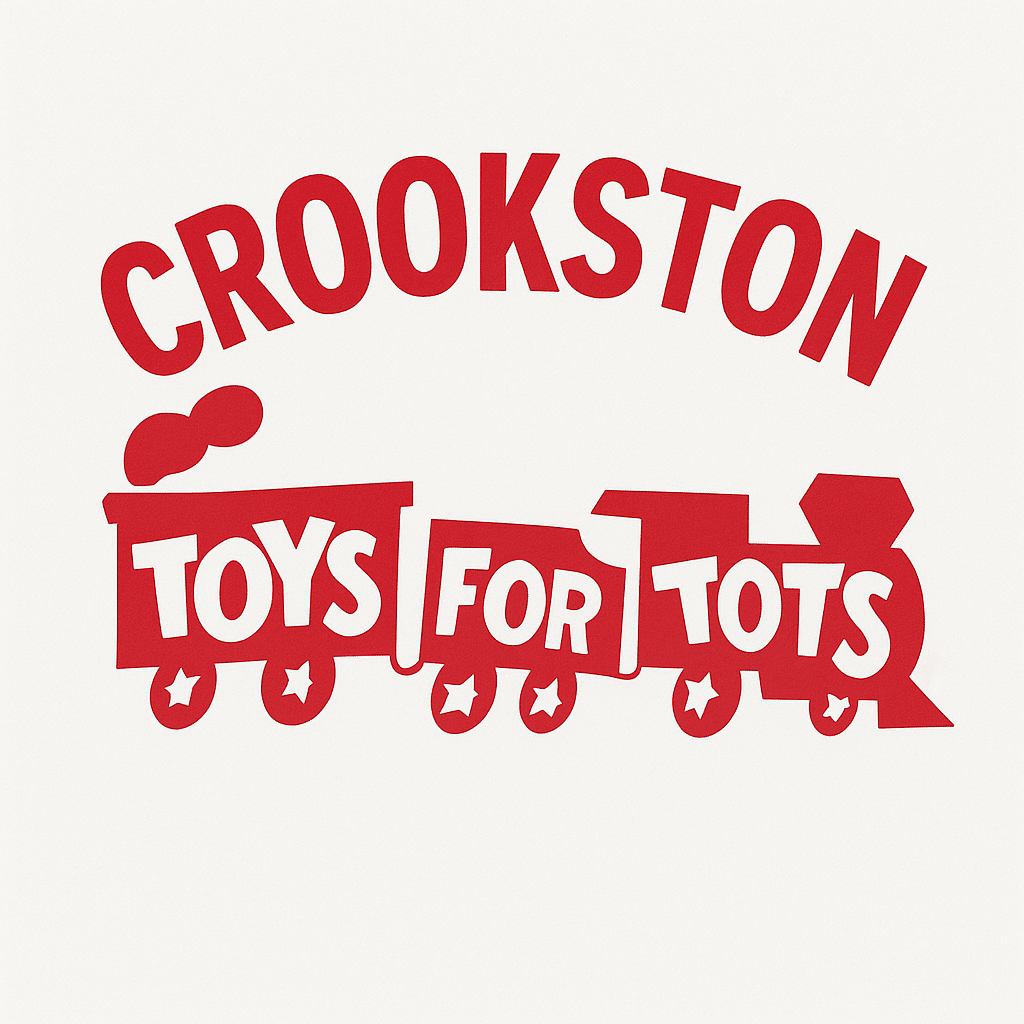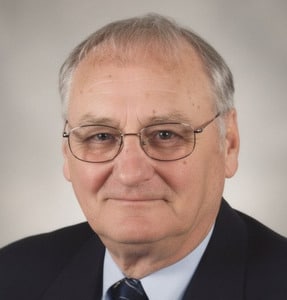The Crookston City Council held a strategic planning session Wednesday night covering a lot of ground discussing the future for Crookston. The meeting covered several core topics and some additional topics, including the role of councilmembers on boards and committees, MnDOT Downtown Highway 2 Corridor Study, child care, recreation programs, Crookston’s image, and whether there is a welcoming atmosphere.
ORGANIZATION/ROLE ON BOARDS AND COMMITTEES
The first core topic covered by the meeting was the city’s organizational structure and the council’s boards and committees’ roles, along with the council members’ roles when on one of those boards or committees, explained City Administrator Amy Finch. “The agenda tonight covered organization structure and process where we reviewed the organization chart and talked about our charter,” said Finch. “We visited about committees and boards and how decision making happens through those and items are then recommended to the City Council. The committees, boards, and commissions do the work to get the information to the council. We talked about the City Council being a strong council making decisions.”
One of the focuses at many committee meetings has been changing the language used to approve an item, such as a variance request for the Ag Innovation campus, to recommend that the City Council approve that request. City Attorney Corky Reynolds told the Council that the Crookston City Charter and its ordinances don’t give decision-making authority to its boards and committees but rather uses them to collect the information and make a recommendation in the best interest of the city. “I indicated that the structure that we have in Crookston with the charter and our ordinances set up what we call standing committees,” said Reynolds. “They are permanently in place, and they have certain functions. In addition to those, there are ad hoc committees that can be made for a particular issue, a particular concern, but they gather information and supply the groundwork. They are kind of the foot soldiers, if you will, for the whole council. Strong council committees gather information, do the work to the present recommendations to the council for actions that should be undertaken.”
Reynolds also talked about the role of the Ways & Means Committee, specifically, its role as is laid out in the city’s ordinances and its typical function, which differs from the role it’s actively played for the City Council over the past several years. “The Ways & Means has performed valuable functions over time,” said Reynolds. “But in the ordinances, its sole duty is to receive the nominations to other committees from the mayor and approve, disapprove, and recommend back what should be done with those members. In the past, it’s had a bigger obligation and, typically, a ways & means committee deals with financial matters. Deals with budgets. It’s not a proving ground or a stepping off ground to deal with issues that the council should properly deal with itself at their regular meetings.”
Councilman Tom Vedbraaten said it seemed the city was “kicking out” the Ways & Means Committee and that he viewed the current format as a “good thing” that also shortened City Council meetings. Reynolds noted that it’s held right after the City Council meeting, so it’s not really shortening the night, adding that those same discussions could and, maybe, should be held during council meetings.
The Council also discussed its role on various committees. Besides the standing committees, council members also have voting authority through the bylaws of several community entities, including but not limited to the Crookston Housing and Economic Development Authority (CHEDA), Crookston Visitor’s Bureau (CVB), Crookston Public Library, and the Downtown Crookston Development Partnership (DCDP).
They discussed how that creates some due roles for the council members and the possibility for a conflict, or perceived conflict of interest, explained Reynolds. “There was good discussion by the members of the council and inquiries about how they act in dual roles,” said Reynolds. “Some of the entities and groups in Crookston have set up their bylaws, so that council members are voting members. Then, they come back to the council as a whole and how do they act when they voted one way on the committee, and then come back to be representing the entire city and the council as a whole. They had questions about that. There are organizations that ask them to sign oaths to be an advocate for that particular group. That potentially creates an issue of a conflict, and they asked us to go back, look, and gather information to bring back to the group again.”
One question was, are you expected to vote the same as you did at that committee at City Council. It was also asked if that was itself a conflict of interest because they may vote for an organization to request money from the city and then be asked to vote at the City Council meeting to allocate money to that organization. Councilwoman Kristie Jerde said asked by swearing an oath to be an advocate and voting at a separate meeting, wouldn’t that be violating the oath of a council member to be open-minded and vote in the best interest of the city, which Reynolds thought was likely in some cases such as CHEDA and perceived in some other cases.
Councilman Clayton Briggs asked whether the councilmembers on those committees could abstain at City Council, and Reynolds said that could create an issue because the City Charter requires five votes to pass anything. With two councilmembers abstaining on certain agenda items, the power to block a request could be held by two individuals.
The Council requested that additional information on the topic be brought to the next strategic meeting, including the bylaws with whom those conflicts could exist so they could look at an alternative form of representation, explained Finch. “Discussed liaisons instead, where you are acting like someone who can bring information between the boards and commissions to council, and the other way,” said Finch. “We need to dive down who is appointed as a voting member versus a liaison. We’re going to do some more work and come back to talk about it. On March 1, we will likely have a recommendation, or at least, more information to guide the discussion on how that might look and what our next steps might be.”
Finch also noted she’d like the council members to filter complaints and requests they receive through her rather than directly with department heads so that she’d have the ability to follow up on them, provide progress updates, and decimate information as needed. She also said she’d like to have a heads up before meetings so either she or the staff could be prepared to respond to anything that needed to be discussed at City Council meetings.
MnDOT DOWNTOWN HIGHWAY 2 CORRIDOR STUDY
The committee also discussed the study proposed by MnDOT for the Highway 2 corridor through downtown. MnDOT Highway 2 Project Manager Matt Upgren told the City Council last week (here) that the additional funding was made available through accessibility funding and was likely a one-time offer to bring Crookston’s Highway 2 corridor into compliance with the Americans with Disabilities Acts (ADA) which is not as simple as replacing the brick with concrete due to non-compliant slopes on the sidewalks.
MnDOT would pay for a study along Highway 2 and have funding for the reconstruction if the city accepted the project. The City of Crookston would be responsible for including any non-Highway 2 streets in the study and the project costs for those streets if approved. Additionally, other funding would be available to cost-share the replacement of lighting along the Highway 2 corridor.
Jerde requested to know how much the corridor study would cost Crookston if it included the city’s downtown streets. She also said that she feels like it could make financial sense for the city to take advantage of MnDOT’s funding. “I really think that with this corridor study, we’re not agreeing to anything,” said Jerde. “But we’re taking advantage of the opportunity that MnDOT is providing for us for the additional monies that are available for ADA. If we did this by ourselves, we’d be paying the full cost. It seems like it makes good financial sense. Granted, once the study is done and we have a better idea of what that would all entail, that this would be a good fit for our city. I think it is important for us to at least explore our options, especially since there is such a good opportunity for financial gain as far as the improvements we wouldn’t have to pay for as a city. I think that’s why we should at least look at it and provide the community an opportunity to see what an ADA-provided space would like as well as some other improvements for downtown that we’re not paying the full bill for.”
Reynolds did note that if a study were presented showing the city’s sidewalks were not in compliance, they would have a legal responsibility to rectify the situation or open themselves up to lawsuits not only for injury but potentially a lack of available access.
Councilman Steve Erickson said a MnDOT had previously shared information about the Highway 2 corridor with the City Council a few years ago and asked Finch if she could get that information from them again. He also said he felt if the city would possibly approve a project for the Highway 2 corridor, they should include all of downtown. “My opinion, if we’re going to do this, we need to look at the big picture and get it all done in one project,” said Erickson. “We’re getting a phenomenal amount of money from MnDOT, and I think we need to utilize that. But, we also need to utilize the side streets that businesses are on. The sidewalks and get it all done. I don’t think we can just do half a project and think we’re done. I think we need to do a full project.”
Finch told the Council she would gather the requested information and study cost estimates from MnDOT. She also said she’d engage department heads on which downtown streets to include in the study before the topic would likely come back up in March. “The Council this evening talked a little about the MnDOT Corridor Study that we heard about at our last City Council meeting,” said Finch. “Decided to engage department heads and Matt Upgren, the MnDOT representative, as to what it might cost us as far as the consulting fee to include our city streets and what city streets those could include. We’re going to get that information back to them for further discussion.”
CROOKSTON’S IMAGE
The next item for discussion was Crookston’s image. Finch noted that the City Council should consider whether Crookston appears welcoming to people moving to town or passing through. She specifically noted she’d heard some discussion about new Welcome to Crookston signs.
Mayor Dale Stainbrook indicated he’d like to see Crookston promote itself more, noting it has been ranked as one of Minnesota’s safest cities and voted as the best drinking water in the state. He also noted the city’s need to promote its opportunities such as recreation.
Councilman Joe Kresl said he thinks the downtown is important, and the possibility of a corridor study and project could help in that area. “I think the downtown is the heartbeat of any area,” said Kresl. “The more pleasing and aesthetically pleasing it is for people driving through – their first impression I think is very important. That’s one thing we need to look at to start drawing some more businesses and just getting to thrive. I think it’s very important for bringing new people into town.”
Another area discussed under the topic was the feeling of the Council Chambers. Stainbrook said they felt like going to the Supreme Court, and Finch said she believed it was an intimidating atmosphere given the setup and lighting. “We talked about the arrangement of the city council chambers,” said Finch. “How it looks and feels to someone coming in that may want to bring an issue forward but doesn’t feel comfortable, doesn’t understand the process. We’ll be working on some things to make that a little more friendly.”
The discussion included how to get people to feel comfortable coming before the City Council. Councilman Wayne Melbye said when he’s known someone was coming to address the City Council, he tried to greet them and talk to them before the meeting, suggesting someone could do that for all meeting attendees. “I think we need one of those Walmart greeters,” said Melbye. “When you come down, there should be somebody sitting there you can ask if you have a question or guide you to a seat, show you where the podium is, and how to address the council. There could also be something on our website that gives you a little insight.”
FUTURE CITY DIRECTION
The last portion of the meeting was dedicated to the future. During that discussion, Kresl said he wanted to take steps to ensure that the city was providing recreation opportunities noting that he thought last year’s decision not to have summer programs hurt Crookston when other towns were offering programs. “I thought I’d bring it up here tonight because I’ve heard discussion around that people think the ball was dropped last year, and it wasn’t thought about enough,” said Kresl. “Our kids really need something to do in the summertime. It not only helps kids and their mental well-being, but it helps parents who have to work. I think we really have to discuss that. With sports going on in the high schools and everything else, I think it’s very important not to leave it to the last minute. Make sure we’re doing everything we can.”
Kresl added that wrestlers don’t have to wear masks, and the Crookston wrestling program hasn’t had any cases of COVID-19 yet this winter. Jerde also said she was concerned about recreation offerings, noting that she often took her kids to the pool and splash park in East Grand Forks because the Crookston splash park never opened. “For me, and I will tell you, I have to give Parks and Rec some grace in this in understanding that 2020 was a rough year for all of us,” said Jerde. “I don’t know if any of us or all of us knew how to manage and go about things. What I’d really like to see as we go forward is if we make decisions at the beginning of the summer or any time we revisit those, especially as we’re seeing other cities around us easing up on restrictions or providing some of those opportunities. I can’t say what the whole story was for last year, but I’d really like to know that we’re keeping in mind the opportunity to revisit and really do what’s best for our parents and kids in this town.”
Stainbrook mentioned he believed finding staff was a difficulty mid-summer after initially canceling programs because the possible pool of employees had taken other summer employment.
Reynolds, who noted he was commenting as a citizen, not as the city attorney, also advocated that the City Council take a lead role in seeking solutions to the child care problem. “As citizen Corky, I can’t think of an issue that is more important to this community than child care,” said Reynolds. “Entities, businesses, groups that want to hire people, that’s a concern for families in Crookston. I just advocated that the council take a leadership role to seek out possible solutions. There is no one right solution, but just be advocates, be decisionmakers, be inquiring about how do we address this critical issue for Crookston.”
Jerde told the Council that she struggled to find child care for her kids when they were born, even having to drive one to Fisher every day for the first six months when she went back to work. She also said she knows of other families where parents needed to quit their job because of a lack of child care even though they probably couldn’t afford to. “It’s sorely needed,” said Jerde. “I could not find child care when I was six months pregnant with my daughter. I called all 29 providers in town and nobody had an opening. I was on multiple waitlists. My husband and I had to drive to Fisher twice a day to have child care. If we’re planning on this city being a place that is welcoming, and that we’re growing our population and making it a thriving population child care is so important. It’s one of the #1 things. I think that we as a city, need to take a lead on that. But, I think there are a lot of opportunities and grants that state can provide us to help support and bring more child care to Crookston.”
Erickson also suggested that the City of Crookston needed to do a better job with marketing and providing a central location such as a master calendar for events. They also discussed ways to get information out. Councilman Clayton Briggs said he’d received some questions from people who said they were unaware of recent grant opportunities (Cares Act and Small Business Relief). Creating an electronic mail list like a listserv or using another entity’s ability to reach people like the Crookston Chamber was discussed.
Melbye said that information was out in the media and on websites where people should be looking for the information. But he also suggested that marketing and telling Crookston’s story was important enough that perhaps they need to consider adding a position solely for that purpose.





